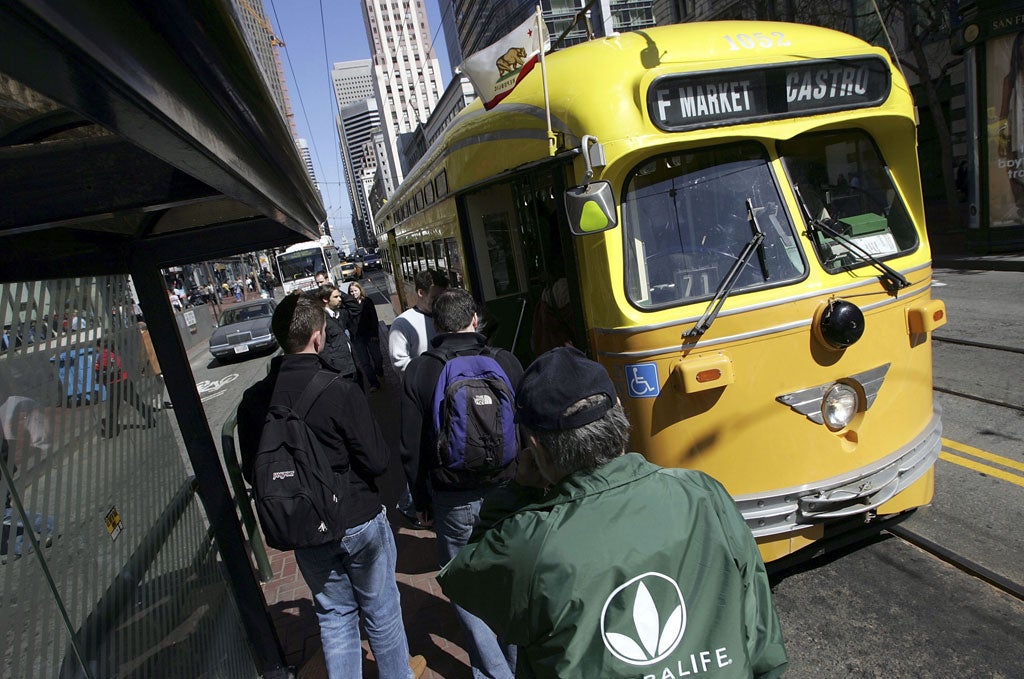Trail of the unexpected: Streetcars in San Francisco
A trip on one of San Francisco's streetcars is the perfect way to see the sights, says Carolyn Lyons.

On a chilly morning in February, San Francisco's Market Street was all but empty. A small group of beefy workers in fluorescent orange jackets and red hard hats stood around some newly poured concrete. Is this the streetcar stop? I asked. James the foreman's eyes lit up. "You're here to ride the cars?" he said. "We've got 50 from all over the world. In fact, we just built them a garage so they don't have to stand out in the rain."
Just as everyone knows about the Golden Gate Bridge (which celebrates its 75th anniversary in May), everyone knows about San Francisco's cable cars. These emblematic vehicles, hauled uphill and eased downhill by steel cables just beneath the road surface, were invented by Andrew Smith Hallidie, a British engineer, in 1873. However, I'd heard that the city was also restoring and running historic "streetcars", as Americans call single-storey trams used as public transport. James told me they had a Blackpool tram, a Melbourne trolley, cars from Portugal and Japan and nine trams from Milan – "they still run streetcars there so they swapped with us" – as well as US cars from the 1920s to the 1950s. Each gets restored and repainted by volunteers before being sent out to run on the F-line between Fisherman's Wharf and the Castro district.
"Tourists ride the cable cars, but we locals use the streetcars. We're real proud of them," James said, pointing down the track to where my streetcar was arriving. Its Cyclops headlight and sleek, bullet-shaped body were painted in the green and yellow of the Twin Cities (as the Minnesota duo of Minneapolis-St Paul is known). I climbed on board and we were off with much clanging of bells, rumbling and sliding down Market Street towards the Bay and the grey clocktower of the Ferry Building.
The Ferry Building is now converted into a huge gourmet food hall, and is the anchor for the mother of all Farmers' Markets on Saturday mornings. From here the streetcar line turns and runs past old, disused warehouses and docks. Today all that remains of San Francisco's nautical history is Fisherman's Wharf – which year after year rates as the city's top tourist attraction, though it looks to me like a tacky collection of gift shops and neon-lit seafood cafés: a low-rent Brighton.
Nevertheless, I walked the Wharf. Right at the end I found a wonderful National Park Service Visitor Center, a free mini-museum telling the history of the waterfront. I learned how the 1849 Gold Rush transformed the city from hamlet to boom town overnight. Since there was no railway, the "Forty-Niners" all arrived by sea, simultaneously turning San Francisco into a bustling port.
Then I took a 1950s San Francisco streetcar for the long ride back into town. The streetcars seem to make everyone happy: the drivers wait for tardy passengers, people smile and talk to one another and offer directions. At $2 a ride (75 cents for concessions) the cars are more affordable than cable cars ($6 fare, no concessions).
At the other end of the F-line, the Castro is San Francisco's gay district, marked by a giant rainbow Gay Pride flag. Unfortunately, the magnificent art deco Castro Theatre was closed so I walked on to number 575 Castro Street. This was the camera shop owned by Harvey Milk, the first openly gay man elected to a major public office in the US. Today the store is dedicated to gay rights. It was selling T-shirts with legends such as "Marriage Is So Gay" and the talk was all of California's hotly disputed ban on gay marriage.
A Los Angeles "red" car took me to my last stop at City Hall, halfway back down Market Street. This 1915 Beaux Arts building has a dome higher than the US Capitol and is decorated with 22-carat gold. Harvey Milk was assassinated here; Joe DiMaggio married Marilyn Monroe here. You can still get married here to this day (although not – at the moment – to someone of the same gender). Or you can take one of the three, free, one-hour tours each day.
During my tour, I saw three weddings. A soldier married a tiny girl in a short lace dress in the middle of the very grand staircase. A Korean couple in national dress got married at the bottom of the stairs. Finally a lavish African-American wedding occupied the balcony, complete with harp. The next day, the guide told me, the city would be honouring Tony Bennett, 50 years after he first sang "I Left My Heart in San Francisco". Everyone had been asked to wear red.
I would have gone but I hadn't packed a red dress – and besides, I still had 47 streetcars left to ride.
The streetcar's the star
The small streetcar museum, called the San Francisco Railway Museum (001 415 974 1948; streetcar.org), is at the Steuart Street stop on the F-line, opposite the Ferry Building. It displays a full-size replica of a streetcar cab, historic photos, and screens tracking the cars in real time across the city. Open 10am-6pm (closed Mondays); admission free. You can also download a poster from the website showing all the cars, then cross off the ones that you ride.
Subscribe to Independent Premium to bookmark this article
Want to bookmark your favourite articles and stories to read or reference later? Start your Independent Premium subscription today.

Join our commenting forum
Join thought-provoking conversations, follow other Independent readers and see their replies